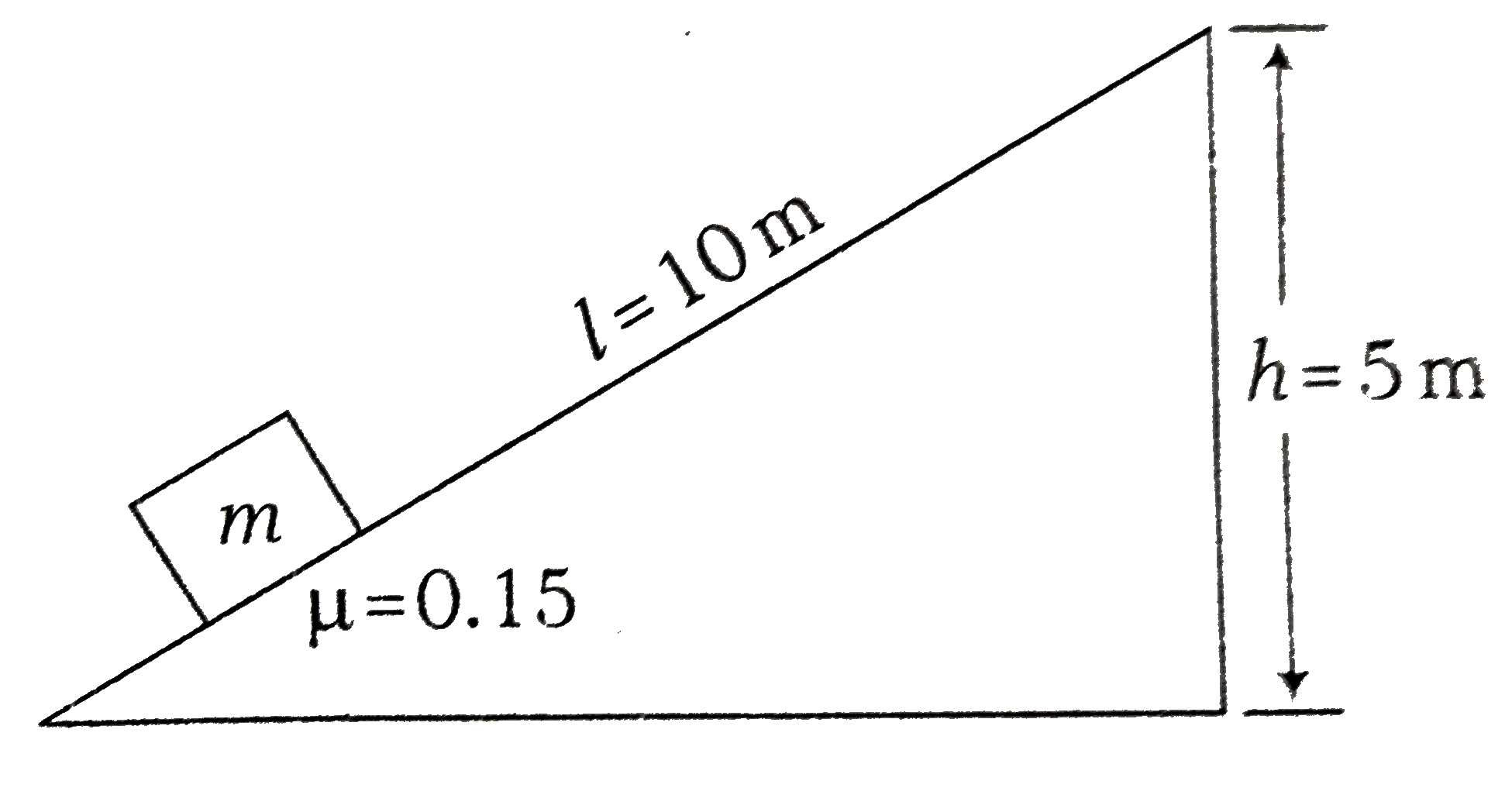A body of mass 0.3 kg is taken up an inclined plane to length 10 m and height 5 m, and then allowed to slide down to the bottom again. The coefficient of friction between the body and the plane is 0.15. What is the kinetic energy of the body at the end of the trip?
To solve the problem step by step, we will follow these steps:
Step 1: Identify the given data
- Mass of the body, m=0.3kg
- Length of the inclined plane, L=10m
- Height of the inclined plane, H=5m
- Coefficient of friction, μ=0.15
- Acceleration due to gravity, g=10m/s2
Step 2: Calculate the angle of inclination
Using the height and length of the inclined plane, we can find the angle θ:
sinθ=HL=510=12
Thus, θ=30∘.
Step 3: Calculate the forces acting on the body
1. Weight of the body: W=mg=0.3×10=3N
2. Component of weight along the incline:
Fgravity=mgsinθ=3sin(30∘)=3×12=1.5N
3. Component of weight perpendicular to the incline:
N=mgcosθ=3cos(30∘)=3×√32≈2.598N
4. Frictional force:
Ffriction=μN=0.15×2.598≈0.3897N
Step 4: Calculate the net force acting on the body while sliding down
The net force Fnet acting down the incline is:
Fnet=Fgravity−Ffriction=1.5−0.3897≈1.1103N
Step 5: Calculate the work done by the net force
The work done W by the net force while sliding down the incline is:
W=Fnet×L=1.1103×10≈11.103J
Step 6: Apply the work-energy theorem
According to the work-energy theorem:
Work done=ΔKE=KEfinal−KEinitial
Since the body starts from rest, KEinitial=0:
KEfinal=W≈11.103J
Final Answer
The kinetic energy of the body at the end of the trip is approximately 11.10J.
---
- Mass of the body, m=0.3kg
- Length of the inclined plane, L=10m
- Height of the inclined plane, H=5m
- Coefficient of friction, μ=0.15
- Acceleration due to gravity, g=10m/s2
Using the height and length of the inclined plane, we can find the angle θ:
sinθ=HL=510=12
Thus, θ=30∘.
1. Weight of the body: W=mg=0.3×10=3N
2. Component of weight along the incline:
Fgravity=mgsinθ=3sin(30∘)=3×12=1.5N
3. Component of weight perpendicular to the incline:
N=mgcosθ=3cos(30∘)=3×√32≈2.598N
4. Frictional force:
Ffriction=μN=0.15×2.598≈0.3897N
The net force Fnet acting down the incline is:
Fnet=Fgravity−Ffriction=1.5−0.3897≈1.1103N
The work done W by the net force while sliding down the incline is:
W=Fnet×L=1.1103×10≈11.103J
According to the work-energy theorem:
Work done=ΔKE=KEfinal−KEinitial
Since the body starts from rest, KEinitial=0:
KEfinal=W≈11.103J
The kinetic energy of the body at the end of the trip is approximately 11.10J.
Topper's Solved these Questions
Similar Questions
A body of mass 0.3kg is taken up an inclined plane of length 10m and height 5m, and then allowed to slide down to the bottom again. The coefficient of friction between the body and the plane is 0.15.
What is the
(a) work done by the gravitational force over the round trip ?
(b) work done by the applied force on the upward journey ?
(c) work done by the frictional force over the round trip ,
(d)kinetic energy of the body at the end of the trip ?View SolutionA body of mass 0.3 kg is taken up an inclined plane of length 10 m and height 5 m, and then allowed to slide down the bottom again. The coefficient of friction between the body and the plane is 0.15. What is the
(i) work done by the applied force over the upward journey?
(ii) work the by gravitational force over the round trip?
(iii)work the by the frictional force over the round trip?
Which of the above forces (except applied force )is/are conservative forces? View Solution
View Solution
Knowledge Check
- Question 1 - Select One
A body of mass 0.5 kg is taken up an inclined plane of length 10 m and height 5 m and then allowed to slide down to the bottom again. The coefficient of friction between the body and the plane is 0.1. The work done by the frictional force over the round trip is
A5 JB5√3JC−5JD−5√3J - Question 2 - Select One
A body of mass 2 kg is placed on rough horizontal plane. The coefficient of friction between body and plane is 0.2 Then,
 Abody will move in forward direction if F = 5 NBbody will be move in backward direction with acceleration 0.5m/s2 if force F = 3NCif F = 3N, then body will be in rest conditionDBoth a and c are correct
Abody will move in forward direction if F = 5 NBbody will be move in backward direction with acceleration 0.5m/s2 if force F = 3NCif F = 3N, then body will be in rest conditionDBoth a and c are correct - Question 3 - Select One
A body of mass 5×10−3 kg is launched upon a rough inclined plane making an angle of 30∘ with the horizontal. Obtain the coefficient of friction between the body and the plane if the time of ascent is half of the time of descent.
A0.346B0.921C1.926D2.912
A body of mass 0.3kg is taken up an inclined plane of length 10m and height 5m, and then allowed to slide down to the bottom again. The coefficient of friction between the body and the plane is 0.15.
What is the
(a) work done by the gravitational force over the round trip ?
(b) work done by the applied force on the upward journey ?
(c) work done by the frictional force over the round trip ,
(d)kinetic energy of the body at the end of the trip ?View SolutionA body of mass 5×10−3 kg is launched upon a rough inclined plane making an angle of 30∘ with the horizontal. Obtain the coefficient of friction between the body and the plane if the time of ascent is half of the time of descent.
View SolutionA body of mass 5×10−3kg is launched upon a rough inclined plane making an angle of 30° with the horizontal. Find the coefficient of friction between the body and the plane if the time of ascent is half of the time of descent.
View SolutionA body of mass m is pushed with the initial velocity v0 up an inclined plane of angle of inclination θ. The co-efficient or friction between the body and the plane is μ. What is the net work done by fnction during the ascent of the body before it comes to stop ?
View SolutionA block of mass 6.0 kg is pushed up an incline to its top by a man and then allowed to slide down to the bottom. The length of incline is 10 m and its height is 5.0 m. the coefficient of friction between block and incline is 0.40. Calculate (a) the work done by the gravitational force over the complete round trip of the block, (b) the work done by the man during the upward journey, (c) the mechanical energy loss due to friction over the round trip, and (d) the speed of the block when it reaches the bottom.
View Solution

